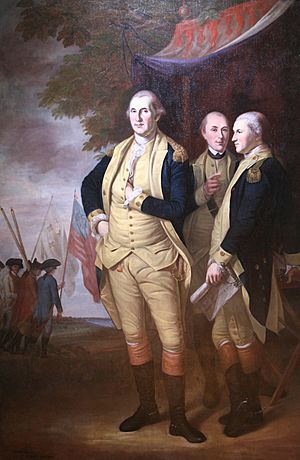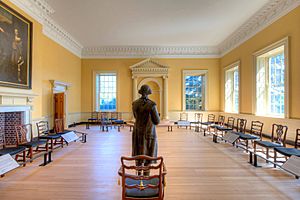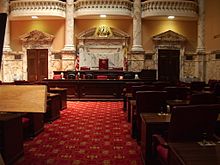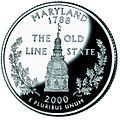Maryland State House facts for kids
Quick facts for kids |
|
|
Maryland State House
|
|

Maryland State House
|
|
| Location | Annapolis, Maryland |
|---|---|
| Built | 1772–1797 |
| Architect | Joseph Horatio Anderson |
| Architectural style | Georgian |
| NRHP reference No. | 66000385 |
| Added to NRHP | October 15, 1966 |
The Maryland State House is in Annapolis, Maryland. It is the oldest U.S. state capitol building that has been used continuously by lawmakers since 1772. Today, it is home to the Maryland General Assembly, the Governor, and the Lieutenant Governor.
From 1783 to 1784, this building was the capital of the United States under the Articles of Confederation. It's also where the American Revolutionary War officially ended on Ratification Day.
The State House has the largest wooden dome in the United States built without using any nails! This building was named a National Historic Landmark in 1960. It is the third statehouse built on this spot.
Contents
Building the State House
Construction of the Maryland State House began in 1772. However, it wasn't finished until 1797 because of the American Revolutionary War.
The building is a two-story brick structure built in the Georgian style. It was designed by architect Joseph Horatio Anderson. The building has a small entrance area with a triangular top, called a pediment. Large rectangular windows are on both floors.
The big dome on top is a special feature. It has a balcony and a lightning rod designed by Benjamin Franklin himself!
In 1818, a low brick wall was built around the State House to keep out cattle. This wall was later replaced by an iron fence in 1836. You can even see the dome of the State House on the Maryland state quarter coin!
Adding More Space
Between 1902 and 1906, a new part, called an annex, was added to the State House. This new section replaced older additions from the 1800s. The current rooms for the House of Delegates and the Senate are in this annex.
The annex is decorated with beautiful black and gold Italian marble. Inside, there's a grand staircase. Above this staircase, you can see a painting called Washington Resigning His Commission by Edwin White, painted in 1858. In 2017, two more paintings were added above the staircase. One is a portrait of Charles Calvert, 5th Baron Baltimore and the other is of Frederick Calvert, 6th Baron Baltimore.
In the mid-1990s, the wooden dome was repaired and repainted. In 2011, the old paint was removed and new white oil-based paint was used.
State House Grounds
For many years, there was a statue of Roger Taney, a former Chief Justice of the United States, on the State House lawn. This statue was put up in 1872.
Because of his past actions and decisions, many people felt the statue should be removed. To help explain the history, special signs were added near the statue. Also, a statue of Thurgood Marshall, the first African American U.S. Supreme Court justice, was placed on the other side of the Capitol. In 2016, it was also decided to add statues of important abolitionists Harriet Tubman and Frederick Douglass inside the State House.
In 2017, after a violent event in Charlottesville, Virginia, leaders in Maryland decided to remove the Taney statue. It was taken down on August 18, 2017.
Inside the Rotunda
The rotunda is a large, round room inside the State House. It is home to the Maryland Federalist. This is a replica of a small ship built in 1788 to celebrate Maryland's approval of the U.S. Constitution.
Large Corinthian columns support the arches that hold up the big dome above. There's also a railing around the second-floor balcony.
Sometimes, important historical documents are displayed here. In 2012, George Washington's original handwritten resignation letter was shown. In 2020, it was displayed again along with the original Star-Spangled Banner manuscript by Francis Scott Key.
Important Rooms
Old Senate Chamber

To the right of the main entrance is the Old Senate Chamber. It has 16 chairs and desks, just like it did originally. The desk for the president of the Senate is an original piece from 1797.
Above the fireplace, you'll see a painting called Washington, Lafayette & Tilghman at Yorktown by Charles Willson Peale. This painting shows General George Washington, Lafayette, and Tench Tilghman.
This room is very famous because it's where George Washington resigned as commander-in-chief of the Continental Army on December 23, 1783. A bronze statue of Washington stands in the room.
On February 2, 1781, Governor Thomas Sim Lee signed a document here that allowed Maryland to approve the Articles of Confederation. This was an important step in forming the United States.
In 1786, the Annapolis Convention was held here. This meeting helped set the stage for the Constitutional Convention in 1787, which created the U.S. Constitution.
Working Senate Chamber
The current Senate chamber is in the newer part of the building, added between 1902 and 1905. A beautiful skylight lights up the room. The floor is covered with a red carpet that has the state seal on it.
Large Ionic columns line the walls and support a viewing area for visitors. The marble on the walls and columns has rust and black colors, which are Maryland's official colors.
Statues of two famous Marylanders stand near the podium: John Hanson, who was the first president under the Articles of Confederation, and Charles Carroll of Carrollton, who signed the Declaration of Independence. Portraits of other Maryland signers of the Declaration of Independence also hang on the walls.
Working House Chamber
The House of Delegates chamber is also in the newer part of the building. The carpet is navy blue with a special design. The same rust and black marble decorates this room, forming Ionic columns along the walls. There's also a gallery above for people to watch the sessions. Portraits of past Speakers of the House hang on the walls.
State House Caucus Room
This room used to be two separate rooms for official records. Later, it was divided into a private office and a cloakroom. Around 1905, it became known as the Flag Room, holding Civil War flags. It was also used as a visitor center. Since 2011, it has been called the State House Caucus Room and is used for meetings.
The Caucus Room displays most of a 48-piece silver service from the ship USS Maryland. These silver pieces show 167 scenes from Maryland's history, with each piece focusing on one of Maryland's 23 counties and Baltimore City.
The room also has many paintings, including portraits of former governors and important figures in Maryland history.
Former National Capital
From November 26, 1783, to August 13, 1784, Annapolis was the capital of the United States. The Congress of the Confederation met in the Maryland State House during this time. Later, Annapolis was considered as a permanent national capital before Washington, D.C. was built.
It was in the Old Senate Chamber that Congress officially approved the Treaty of Paris on January 14, 1784. This treaty formally ended the American Revolutionary War.
Images for kids
-
The dome of the statehouse is shown on the Maryland state quarter.
See also
 In Spanish: Casa del Estado de Maryland para niños
In Spanish: Casa del Estado de Maryland para niños









